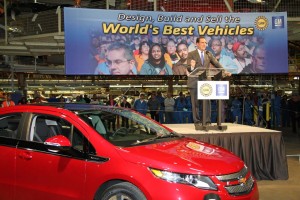
GM North American President Mark Reuss during an appearance at the plant producing the Chevrolet Volt.
Despite the slow start-up of sales, “The electric car is not dead,” General Motors President Mark Reuss insists, adding that the maker “couldn’t be happier” with its Chevrolet Volt despite the plug-in hybrid missing its sales target for the second year in a row.
During an appearance at an industry conference coinciding with the North American International Auto Show, Reuss insisted the maker is hoping to take “thousands” out of the cost of the next-generation Volt when it comes to market. Key rival Nissan earlier this week announced plans to introduce a new base version of its own Leaf battery-electric vehicle that will cost $6,000 less than the original model.
“The electric car is not dead,” proclaimed Reuss, the head of GM’s core North American operations during the Automotive News World Congress, “despite what you might hear, and despite what you might read about Americans not being ready for it, or about it being ‘under attack’ by local governments retracting incentives for it.”
Battery car sales have clearly lagged expectations – Nissan CEO Carlos Ghosn admitting to reporters at the Detroit Auto Show he was “disappointed” with demand for the maker’s own Leaf battery-electric model. Even with conventional hybrids included, all battery-based vehicles accounted for barely 3.5% of the U.S. market last year.
(Nissan to slash price of new base model Leaf electric vehicle by $6,000.Click Here for that story.)
Nonetheless, Reuss insisted the industry is in the midst of a “transformation here and transformation takes time. It takes a long time to change an industry, to change habits, and to change a way of life,” he said, adding that those who have purchased a Chevy Volt are indicating they are more pleased with the vehicle than owners of the high-performance Porsche 911.
Nonetheless, he also made it clear that GM, like Nissan and other battery car makers, is well aware that the high price for the technology has been limiting demand.
Reuss echoed other GM executives who have promised that prices will come down with successive generations of the Volt. Among other things, the maker is looking to reduce the mass of the underlying electric drive technology, he said, and “When you do that then you can make the battery pack smaller,” he said. It also makes the car less expensive.”
GM demonstrated its commitment to electric propulsion this past week with the launch of its latest plug-in hybrid, the Cadillac ELR. Sharing the same underlying drive system as the Chevy Volt, the new Cadillac model adds a range of luxury features. Pricing won’t be announced until later this year, but is expected to run thousands of dollars higher than for the Volt.
The GM president touched on a wide range of topics during his speech, among other things noting General Motors plans to spend $1.5 billion on new plant and equipment in the next 12 months.
The biggest challenge General Motors faces in the next year is getting all of its new products launched and launched well. Among the critical new offerings coming to market are the Caddy ELR, the redesigned Chevrolet Silverado pickup, and Chevy’s seventh-generation Corvette.
In all, Chevy and Cadillac alone have 23 new products on tap. GM, which spends $8 billion annually on product development, is expected to have replaced about 70 percent of its lineup by year’s end.
“We have to build all these new products right,” Reuss said, stressing “This is a very big year for us.”
The $1.5 billion in new spending is over and above the spending on product development, which also will continue at a brisk clip, roughly $8 billion, over the next year.
Asked by reporters later what factories will be impacted, Reuss said, “We’ll have the list of plants soon.”
That’s good news for those hoping to see things turn around in American manufacturing, the executive noted, pointing out that, “For our part, GM has announced North American facility investment of over $10.2 billion since July 2009, creating or retaining more than 26,500 jobs.”
GM officials have been clearly celebrating a strong week that began with the launch of the all-new Corvette during an auto show preview last Sunday night and went on, the following day, to see the launch of the new Silverado and the announcement that the Cadillac ATS had won the coveted North American Car of The Year award.
The “C7” Corvette has “been the symbol of American engineering, styling and capability,” boasted the executive, and it was clearly among the stars of the 2013 North American International Auto Show, with its new LT1 V-8 engine expected to produce 450 horsepower and launch from 0 to 60 in under 4 seconds, which would make the 2014 model the fastest and most powerful “base” Chevrolet Corvette ever.
It also has a Lighter, stiffer structure, with advanced technology carbon fiber masterfully blended with high strength steel on all models and a perfect 50/50 weight balance and a a beautiful new interior with outstanding craftsmanship and attention to detail, he added.
Paul A. Eisenstein contributed to this report.
